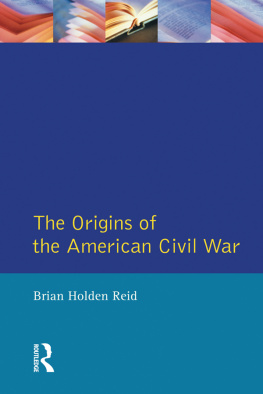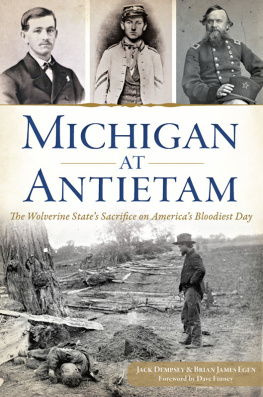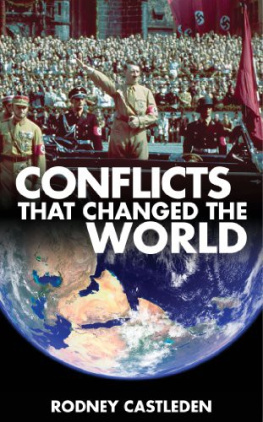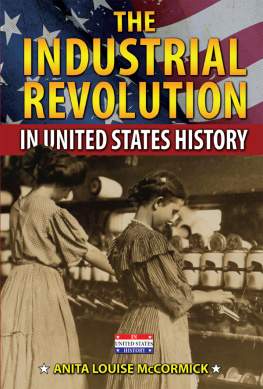ALSO BY JOHN KEEGAN The Iraq War
Intelligence in War
The First World War
The Face of Battle
The Nature of War (with Joseph Darracott)
World Armies
Whos Who in Military History (with Andrew Wheatcroft)
Six Armies in Normandy
Soldiers (with Richard Holmes)
Warpaths
The Mask of Command
The Price of Admiralty
The Second World War
A History of Warfare
Fields of Battle
The Battle for History
War and Our World: The Reith Lectures 1998
An Illustrated History of the First World War
Churchill: A Life
To Lindsey Wood
CONTENTS
23.
MAPS


INTRODUCTION I began an earlier book with the sentence The First World War was a cruel and unnecessary war. The American Civil War, with which it stands comparison, was also certainly cruel, both in the suffering it inflicted on the participants and the anguish it caused to the bereaved at home. But it was not unnecessary. By 1861 the division caused by slavery, most of all among other points of division between North and South, was so acute that it could have been resolved only by some profound shift of energy, certainly from belief in slavery as the only means by which Americas colour problem could be contained, probably by a permanent separation between the slave states and their sympathisers and the rest of the country, and possibly, given the ruptions such a separation would have entailed, by war. That did not mean, however, that war was unavoidable. All sorts of political and social variables might have led to a peaceful resolution. Had the North had an established instead of a newly elected president, and a president whose anti-slavery views were less provocative to the South; had the South had leaders, particularly a potential national leader, as capable and eloquent as Lincoln; had both sections, but particularly the South, been less affected by the amateur militarism of volunteer regiments and rifle clubs which swept the Anglo-Saxon world on both sides of the Atlantic in mid-century; had industrialisation not so strongly fed the Norths confidence that it could face down Southern bellicosity; had Europes appetite for Southern cotton not persuaded so many planters and producers below the Mason-Dixon line that they had the means to dictate the terms of a separatist diplomacy to the world; had so many had nots not clustered in the mentality of both North and South, then simple and scant regard for peace and its maintenance might have overcome the clamour of marching crowds and recruiting rallies and pointed the great republic through the turmoil of war fever to the normality of calm and compromise. Americans were great compromisers. Half a dozen major compromises had averted the crisis of division already during the nineteenth century. Indeed, a tacit resort to compromise had led the whole country to adopt compromise as the guiding principle of relations with the old colonial overlords at the beginning of the century and to forswear conflict with Britain, after the aberration of the War of 1812, in perpetuity. Unfortunately, Americans were also people of principle. They had embodied principle in the guiding preambles to their magnificent governing documents, the Declaration of Independence and the Constitution and the Bill of Rights, and, when aroused, Americans resorted to principle as their guiding light out of trouble. Even more unfortunately, the main points of difference between North and South in 1861 could be represented as principles; the indivisibility of the republic and its sovereign power and states rights both had to do with the passions of the republics golden age and could be invoked again when the republics survival was under threat. They had been invoked, iterated, and reiterated throughout the political quarrels of the centurys earlier decades by protagonists of great sincerity and eloquence, Henry Clay and John Calhoun. It was finally unfortunate that America produced opinion leaders of formidable persuasiveness. It was the Souths ill fortune that, having dominated the debate in the first half of the century, at precisely the point when the issue of principle ceased to be a contest of words and threatened to become a call to action, the North had produced a leader who spoke better and more forcefully than any of the Souths current champions.War must have been very close beneath the surface of debate in 1861, for scarcely had the South moved to the level of organisation for secession than it was appointing not only its own Confederate president but also a secretary for war, as well as secretaries of state and of the treasury and the interior. Scarcely had President Lincoln assumed office before he was embodying the militias of the Northern states for federal service and calling for volunteers in tens of thousands. In only a few weeks one of the most peaceable polities in the civilised world was bristling with, if not armed men, then men demanding arms and marching and drilling in the manual of arms. It would take time for the arms to appear. The delay would not, however, abate the turmoil, for the challenge to the republics integrity and authority had aroused profound popular passions. In the Old World, it had become, through struggles for national liberation, as much in the Spanish-speaking part of the continent as in the English-speaking half, the concern of populations. The Americas of 1861, North and South alike, had decided by unspoken consensus that the issues of principle the quarrel provoked by the election of Abraham Lincoln was grave enough to be fought over. The decision was to invest the coming conflict with a grim purpose. It would become a war of peoples, and those of each side, who had hitherto considered themselves one, would henceforth begin to perceive their differences and to consider their differences more important than the values that, since 1781, they had accepted as permanent and binding. The coming war would thus be a civil war, and it was quickly so called and recognised to be. In the meantime, however, the leaders of North and South turned to consider what form the war should take if war overtook their peoples. The matter, for the South, was simple. It would defend its borders and repel any invaders who appeared. For the North, things were not so simple. Any war would be a rebellion, a defiance of its authority which had to be defeated; but how and, more crucially, where should defeat be inflicted? The South formed half the national territory, an enormous area that touched the Norths organised regions at only a few widely separated points. There was contact between the South and the Norths region of great cities in the Atlantic coast corridor of Maryland and Pennsylvania, a region amply supplied with railroads; there were some tenuous connections between North and South in the Mississippi Valley, where there were extensive riverine links, but a dearth of cities and population. As a result, when war broke out in April 1861, it began in a haphazard, unplanned, and largely undirected form, the embryo armies falling upon each other as and when found. The first encounters would occur in what would become the state of West Virginia, minor engagements on what the correspondent of the London Times would dismiss as unfought fields. It was greatly to the Souths advantage that the first major battle of the war, First Manassas, or First Bull Run, resulted in a Southern victory, though it had lamentable consequences for the United States. This unexpected victory disheartened the North but persuaded the South that ultimate victory was attainable. Had the battle gone the other way, as it might so easily have done, the war might have been concluded more quickly and at much lower cost both to North and South.As it was, after Bull Run, the war had to be fought as a major undertaking, needing the fullest commitment of resources by both sides. Yet Bull Run did not point the way forward for either North or South. It still consigned the South to the defensive, without revealing to Lincoln and his generals how a successful offensive might be conducted. The much maligned General George McClellan, an organiser of genius but a halfhearted strategist and warrior, conceived the scheme of taking the Army of the Potomac from the environs of Washington and shipping it by water down Chesapeake Bay to the approaches to Richmond. It was a fruitful and well-reasoned conception, since it promised to avert a series of contested river crossings in northern Virginia during an approach march from one capital to the other. What it spared the Union army was demonstrated by Grants Overland Campaign of 1864, when he did indeed have to fight every step of the way in a series of bloody battles that included Spotsylvania and Cold Harbor. The Peninsula Campaign, as McClellans enterprise was called, deserved to yield great results, but its originators timidity robbed it of outcome, obliging the Army of the Potomac to return to profitless frontal battles around Washington. The failure of the Peninsula Campaign also fostered the emergence of General Robert E. Lee, who was to frustrate all the Army of the Potomacs offensive efforts for three years, while leading several of his own into Union territory.A successful Union strategy, though long debated, eventually emerged only accidentally, when General U. S. Grants victory at Forts Henry and Donelson led him to make the first serious penetration of Confederate territory down the Tennessee River. Grant thereby inaugurated the campaign in the West, actually the south-central United States. Grant was to inaugurate two other strategies, that of living off the country and that of inflicting casualties. Several major Union leaders, including Winfield Scott, the general in chief, and his successor, George McClellan, shrank from making the Confederacy pay in blood for its rebellion, believing that time and a milder way of making war would wean the South, which was believed to contain a large, hidden constituency of Unionists, away from war and into a mood of reconciliation. Grant took no such tepid view. Though not a bloodthirsty man, he believed that only fierce blows would bring the war to an end and, though deploring the effusion of blood, he always fought to win. His first great battle, following Forts Henry and Donelson, at Shiloh was a ghastly bloodletting, which introduced the country to the nature of the conflict they had undertaken. The introduction was salutary, for thereafter the casualty lists rose inexorably. Thus the Civil War became unintentionally a body-count war, as the United States later war in Vietnam was to be a body-count war. Populous North Vietnam would be able to sustain a body-count war, in the 1960s sacrificing 50,000 of its young men each year to death at the hands of the U.S. Army and its allies and replacing them the following year without faltering in its war effort. The American South could not bear such a cost. In 1861-64, it appeared to be able to replace those lost in battle or by the diseases of war without weakening, but the appearance of invulnerability was deceptive. The war progressively bled the South to death, while the more populous North, suffering though it was, made good the numbers and continued to fight. As the North ate into the Souths stock of fighting men, approximately a million strong, it was also eating into the Souths landmass. The Shiloh campaign inaugurated Grants bisection of the South, while also inflicting heavy losses. Bisection was followed by fragmentation, first when Grant cut across southern Tennessee to reach southern Georgia, then dividing the Lower South from the border states. Thereafter Grant was able to chew the South up into smaller and smaller fragments, inflicting losses all the time.The South, or in particular the Army of Northern Virginia, under Lees command, was not able to inflict similar damage on the North. Lees invasions of Pennsylvania and Maryland were little more than large-scale raids. Neither secured permanent footholds, and while Lee secured large body counts, particularly at Antietam and Fredericksburg, his battles cost him dear. After the failure of his invasions, Lee no longer had a strategy in the east. He could only maintain a strong defence, while watching the North develop an increasingly effective strategy in the west.The American Civil War is one of the most mysterious great wars of history, mysterious because unexpected, mysterious also because of the intensity with which it took fire. It was a great part of the mystery that a civil war should have broken out in a country which from its earliest times had devoted itself to peace between men, to the brotherhood of its inhabitants, as its largest city, Philadelphia, proclaimed, on the outbreak of the Civil War. The Civil War is also mysterious because of its human geography, a war which at the outset seemed rooted in the immediate locality of the two capitals, Washington and Richmond, but then, like an exotic invader from a tropical flora, sprang up at a distance from the Virginia battlefields, in Tennessee, Missouri, and Louisiana, often apparently without any cross-fertilisation. Abraham Lincoln, the new president in 1861, said that the war was in some way about slavery, but in 1862 and 1863 it put out massive aggressive shoots in parts of what had been the United States where slavery was a very subordinate feature of economic and social life. Indeed, as we now know, many Southerners had no personal connection with slavery at all, neither as owners of slaves nor as employers of their labour. The considerable slave owners were, indeed, often resented by their non-slave-owning neighbours, though that did not deter them from joining in their thousands in the new Confederate army and in fighting with terrifying ferocity and admirable military proficiency in the battles it conducted with the army of the Union. There was another mystery of the war: why should men who lacked a rational interest in the war struggle so fiercely against Northerners who, in their present circumstances, were frequently not to be distinguished from their poor Southern opponents? In the South the lack of direct personal motivation was often apparent as a paradox, a rich mans war, but a poor mans fight, emphasising the undeniable fact that the gray ranks were but sparsely populated with large slave owners or their sons, but enormously by hardscrabble farmers and often by men who owned nothing at all.The relative wealth of North and South also adds a mysterious dimension to the war. In flat balance-book form, the South ought not to have been rich enough to sustain a serious war effort against the North. The per capita wealth of the South was greater than that of the North but only because of the market value of slaves and the cash crops they produced, wealth which was in private hands. The capital and revenue values of the Northern economy vastly exceeded those of the South because they produced essential raw materialsiron, steel, non-ferrous metals, coal, chemicalsin large quantities, and had access to transport terminals, which the South did not. Even more deficient was the Souths output of manufactured goods. By 1861, the North had become an exporter of coal and steel on its own account; by 1900 its production of essential war materials would exceed that of the United Kingdom. This reversal of commercial fortunes was already anticipated at the outbreak of the Civil War.The ability of an enemy that was economically outclassed as well as outnumbered by the other side, as the South was by the North, to prosecute struggle on such a large scale compounds the mystery of the war.










